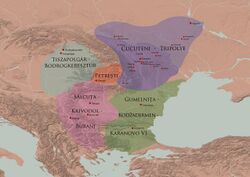History:Gumelnița–Kodžadermen-Karanovo VI complex
 | |
| Horizon | Old Europe |
|---|---|
| Period | Chalcolithic |
| Dates | c. 4500 BC – c. 4000 BC |
| Preceded by | Karanovo V, Hamangia culture, Boian culture |
| Followed by | Cernavodă culture, Karanovo VII |
The Gumelniţa–Kodžadermen-Karanovo VI complex was a Chalcolithic cultural complex of the fifth millennium BC located in the eastern Balkans, comprising the Gumelnița, Kodžadermen and Karanovo cultures. It is also aggregated with the Varna culture. It formed part of the broader cultural complex known as Old Europe. Gumelniţa–Kodžadermen-Karanovo VI evolved out of the earlier Boian culture and phase V of the Karanovo culture. From c. 4000 BC Gumelniţa–Kodžadermen-Karanovo VI was replaced by the Cernavodă culture.
Danube script
During the Middle Copper Age, the Danube script appears in three horizons: The Gumelniţa–Kodžadermen-Karanovo VI cultural complex (mainly in Bulgaria, but also in Romania), the Cucuteni A3-A4–Trypillya B (in Ukraine), and Coțofeni I (in Serbia). The first, rates 68.6% of the frequencies; the second, rates 24.2%; and the third, rates 7.6%.[1]
See also
- Old Europe
- Vinča culture
- Tărtăria tablets
- Vinča symbols
- Sesklo culture
- Cucuteni–Trypillia culture
- Hamangia culture
- Butmir Culture
- Tisza culture
- Linear Pottery culture
- Lengyel culture
- Funnelbeaker culture
References
- ↑ Merlini, Marco (2009). "SOME KEY FEATURES OF THE DANUBE HOMO SCRIBENS BASED ON THE DATABANK DATDAS". Acta Terrae Septemcastrensis VIII: 35-64. https://magazines.ulbsibiu.ro/arheologie/publicatii/ats/ats8%201/acta%208.pdf. Retrieved 2022-07-18.
Bibliography
- Stefan Hiller, Vassil Nikolov (eds.), Karanovo III. Beiträge zum Neolithikum in Südosteuropa Österreichisch-Bulgarische Ausgrabungen und Forschungen in Karanovo, Band III, Vienna (2000), ISBN:3-901232-19-2.
External links
- Gumelnița culture museum
- Brukenthalmuseum.ro
- Civa.uv.ro
- Civa.uv.ro
- Bulgariatravel.org
- Worldmuseumofman.org
- Culture.gouv.fr
- Cimec.ro
- Cimec.ro
- Arheologie.ulbsibiu.ro
- Larson, Greger; Albarella, Umberto; Dobney, Keith; Rowley-Conwy, Peter; Schibler, Jörg; Tresset, Anne; Vigne, Jean-Denis; Edwards, Ceiridwen J. et al. (25 September 2007). "Ancient DNA, pig domestication, and the spread of the Neolithic into Europe". Proceedings of the National Academy of Sciences 104 (39): 15276–15281. doi:10.1073/pnas.0703411104. PMID 17855556.
- Institute for the Study of the Ancient World
 |

